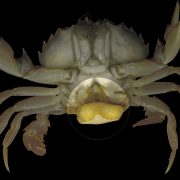New paper out
Tidal elevation and parasitism: patterns of infections of the rhizocephalan parasite Sacculina carcini in shore crabs Carcinus Maenas
Waser, A. M., Goedknegt, M. A., Dekker, R., McSweeney, N., Witte, J. IJ., van der Meer, J., Thieltges, D. W.
Marine Ecology Progress Series 545:215-225, doi: 10.3354/meps1159 (2016)
While the distinct zonation patterns of benthic organisms along intertidal elevationgradients have been extensively documented, relatively little is known about the impact that tidalelevation has on the distribution and abundance of marine parasites that are common in intertidalecosystems. In this study, we investigated the distribution of shore crabs Carcinus maenas infected with the rhizocephalan parasite Sacculina carciniat 12 locations and in 3 adjacent habi-tats (intertidal mussel beds, intertidal bare sand flats and subtidal gullies) along a tidal elevationgradient in the Dutch Wadden Sea. Our sampling revealed that of the 27 629 crabs investigated,most infected crabs were found in the subtidal gullies and almost none on intertidal bare sand flatsor mussel beds at all of the 12 locations. This probably resulted from a parasite-induced manipulation of infected crabs to behave like egg-bearing females which migrate towards deeper waters,as the same pattern was observed in the distribution of non-infected ovigerous females. Theprevalence of both infected crabs and ovigerous females in the gullies was significantly correlatedwith water depth, and both tended to increase (albeit not significantly) with increasing salinity. As water depth and salinity are expected to affect larval survival of both parasites and crabs, this sug-
gests that the migration into subtidal habitats may result in favourable conditions for reproduction and dispersal. By using a replicated and nested sampling design as well as a large sample size, ourstudy significantly increases the limited understanding of parasite distributions along tidal eleva-
tion gradients.




Leave a Reply
Want to join the discussion?Feel free to contribute!